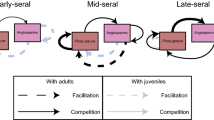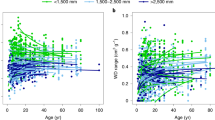Summary
Recent critical reviews suggest the need for a reductionistic approach to the study of secondary plant succession. We propose viewing succession as the result of the underlying plant population dynamics. This approach is being developed using nearly 50 years of permanent sample plot records.
After initial establishment Pinus taeda shows an exponential depletion with stands of various densities conforming to the reciprocal yield relationship. Uneven-aged hardwoods also show exponential depletion. Canopy disturbance can enhance the establishment process, though severe disturbance and the consequent abundant regeneration can lead again to dense, even-aged stands with low levels of establishment. These results suggest a general pattern of forest development wherein establishment is initially important, but is quickly replaced by mortality as the dominant process when the dense, even-sized stand starts to thin. Eventually, failing additional disturbance, natural mortality will again open the canopy allowing development of a balance between establishment, and mortality.
Similar content being viewed by others
References
Auclair, A.N. & F.G.Goff. 1971. Diversity relations of upland forests in the Western Great Lakes area. Amer. Nat. 105: 499–528.
Billings, W.D. 1938. The structure and development of old field shortleaf pine stands and certain associated physical properties of the soil. Ecol. Monogr. 8: 437–499.
Bormann, F.H. & G.E.Likens. 1979. Pattern and process in a forested ecosystem. Springer-Verlag, N.Y., 253 pp.
Botkin, D.B., J.F.Janak & J.R.Wallis, 1972. Some ecological consequences of a computer model of forest growth. J. Ecol. 60: 849–872.
Buell, M.F., A.W.Langford, D.W.Davidson & L.F.Ohmann. 1966. The upland forest continuum in northern New Jersey. Ecology 47: 416–432.
Christensen, N.L. 1977. Changes in structure, pattern, and diversity associated with climax forest maturation in Piedmont, North Carolina. Amer. Midl. Nat. 97: 176–188.
Connell, J.H. & R.O.Slatyer. 1977. Mechanisms of succession in natural communities and their role in community stability and organization. Amer. Nat. 111: 1119–1144.
Drew, T.J. & J.W.Frewelling. 1977. Some recent Japanese theories of yield-density relationships and their application to Monterey Pine plantations. For. Sci. 23: 517–534.
Drury, W.H. & I.C.T.Nisbet. 1971. Inter-relations between developmental models in geomorphology, plant ecology and animal ecology. Gen. Sys. 16: 57–68.
Drury, W.H. & I.C.T.Nisbet. 1973. Succession. J. Arnold Arb. 54: 331–368.
Egler, F.E. 1954. Vegetation science concepts. I. Initial floristic composition — a factor in old-field vegetation development. Vegetatio 4: 412–417.
Egler, F.E. 1976. Nature of vegetation. Its management and mismanagement. Conn. Cons. Assoc., Bridgewater, Conn., 527 pp.
Goff, F.G. & D.West. 1975. Canopy-understory interaction effects on forest population structure. For. Sci. 21: 98–108.
Good, N.F. 1968. A study of natural replacement in six stands in the highlands of New Jersey. Bull. Torrey Bot. Club 95: 240–253.
Harper, J.L. 1977. Population biology of plants. Academic Press, N.Y., 892 pp.
Hartshorn, G.S. 1975. A matrix model of tree population dynamics. In: F.B.Golley & E.Medina (eds.), Tropical ecological systems. p. 41–52, Springer-Verlag, N.Y.
Hett, J.M. 1971. A dynamic analysis of age in sugar maple seedlings. Ecology 52: 1071–1074.
Horn, H.S. 1974. The ecology of secondary succession. Ann. Rev. Ecol. Syst. 5: 25–37.
Horn, H.S. 1975. Markovian properties of forest succession. In: M.L.Cody & J.M.Diamond (eds.), Ecology and evolution of communities. p. 196–211, Belknap Press, Cambridge, Mass.
Horn, H.S. 1976. Succession. In: R.M.May (ed.), Theoretical ecology: principles and applications. p. 187–204. Blackwell, London.
Hulst, R.van. 1978. On the dynamics of vegetation: patterns of environmental and vegetational change. Vegetatio 38: 65–75.
Keever, C. 1973. Distribution of major forest species in southeastern Pennsylvania. Ecol. Monogr. 43: 303–327.
Kira, T., H.Ogawa & K.Shinozaki. 1953. Intraspecific competition among higher plants. I. Competition-diversity-yield interrelationships in regularly dispersed populations. J. Inst. Polytech. Osaka City Univ. D 4: 1–16.
Korstian, C.F. & T.S. Coile. 1938. Plant competition in forest stands. Duke Univ. For. Bull. 3. 125 pp.
Kozlowski, T.T. 1949. Light and water in relation to growth and competition of piedmont forest tree species. Ecol. Monogr. 19: 207–231.
Loucks, O.L. 1970. Evolution of diversity, efficiency, and community stability. Amer. Zool. 10: 17–25.
Major, J. 1974. Biomass accumulation in successions. In: R.Knapp (ed.), Vegetation dynamics, Handbk. Veg. Sci. 8: 195–203, Junk, The Hague.
Margalef, R. 1968. Perspectives in ecological theory. Univ. Chicago Press. 111 pp.
Moser, J.W. 1972. Dynamics of an uneven-aged forest stand. For. Sci. 18: 184–191.
Niering, W.A. & F.E.Egler. 1955. A shrub community of Viburnum lentago, stable for twenty-five years. Ecology 36: 356–360.
Noble, I.R. & R.O. Slatyer. 1977. Post-fire succession of plants in Mediterranean ecosystems. In: H.A. Mooney & C.E. Conrad (eds.), Symposium on the environmental consequences of fire and fuel management in Mediterranean ecosystems. p. 27–36. U.S.D.A. For. Serv. Gen. Tech. Rpt. WO-3.
Noble, I.R. & R.O. Slatyer. 1980. The use of vital attributes to predict successional changes in plant communities subject to recurrent disturbances. Vegetatio 43: ...-....
Odum, E.P. 1969. The strategy of ecosystem development. Science 164: 262–270.
Oosting, H.J. 1942. An ecological analysis of the plant communities of Piedmont, North Carolina. Amer. Midl. Nat. 28: 1–126.
Peet, R.K. 1978. Forest vegetation of the Colorado Front Range: Patterns of species diversity. Vegetatio 37: 65–78.
Peet, R.K. 1980a. Forest vegetation of the Northern Colorado Front Range, U.S.A.: II. Forest structure. Vegetatio (in press).
Peet, R.K. 1980b. Ordination as a tool for analyzing complex data sets. In: E. van der Maarel (ed.), Advances in vegetation science: Classification and Ordination. Vegetatio 42: ...-....
Peet, R.K. & N.L. Christensen. 1979. Hardwood forest vegetation of the North Carolina piedmont. Veröff. Geobot. Inst. ETH, Stiftung Rübel, 1979 (in press).
Peet, R.K. & O.L.Loucks. 1977. A gradient analysis of southern Wisconsin forests. Ecology 58: 485–499.
Pickett, S.T.A. 1976. Succession: an evolutionary interpretation. Amer. Natur. 110: 107–119.
Sarukhan, J. 1978. Studies on the demography of tropical trees. In: P.B.Tomlinson & M.H.Zimmermann (eds.), Tropical trees as living systems, p. 163–184. Cambridge Univ. Press, Cambridge.
Shugart, H.H., T.R.Crow & J.M.Hett. 1973. Forest succession models: a rationale and methodology for modeling forest succession over large regions. For. Sci. 19: 202–212.
Usher, M.B. 1966. A matrix approach to the management of renewable resources, with special reference to selection forests. J. Appl. Ecol. 3: 355–367.
Vitousek, P.M. 1977. The regulation of element concentrations in mountain streams in the northeastern United States. Ecol. Monogr. 47: 65–87.
Vitousek, P.M. & W.A.Reiners. 1975. Ecosystem succession and nutrient retention: a hypothesis. Bioscience 25: 376–381.
Whitaker, R.H. 1972. Evolution and measurement of species diversity. Taxon 21: 213–251.
Whittaker, B.H. 1975. Communities and ecosystems. MacMilland, N.Y. 385 pp.
Whittaker, R.H. 1977. Evolution of species diversity in land communities. Evol. Biol. 10: 1–67.
Whittaker, R.H. & P.L.Marks. 1975. Methods of assessing terrestrial productivity. In: H.Lieth & R.H.Whittaker (eds.), Primary productivity of the biosphere. Ecol. Stud. 4: 55–118. Springer-Verlag, N.Y.
Whittaker, R.H. & G.M.Woodwell. 1968. Dimension and production relations of trees and shrubs in the Brookhaven forest, New York. J. Ecol. 56: 1–25.
Yoda, K., T.Kira, H.Ogawa & H.Hozumo. 1963. Self-thinning in overcrowded pure stands under cultivation and natural conditions. J. Biol. Osaka City Univ. 14: 107–129.
Author information
Authors and Affiliations
Additional information
This research was supported by National Science Foundation grants DEB-7708743 and DEB-7804043 to R.K.P. and DEB-7707532 and DEB-7804041 to N.L.C.
Rights and permissions
About this article
Cite this article
Peet, R.K., Christensen, N.L. Succession: A population process. Vegetatio 43, 131–140 (1980). https://doi.org/10.1007/BF00121025
Accepted:
Issue Date:
DOI: https://doi.org/10.1007/BF00121025




